Dynamic Displacement Forecasting of Dashuitian Landslide in China Using Variational Mode Decomposition and Stack Long Short-Term Memory Network
Abstract
:1. Introduction
2. Stack Long Short-Term Memory Network
2.1. LSTM Network
2.2. Training Method of the SLSTM Network
3. Dynamic Forecasting Model Based on VMD-SLSTM Network
3.1. Variational Mode Decomposition
3.2. VMD-SLSTM Forecasting Model
3.3. Dynamic Forecasting Process
4. A Real Application Case
4.1. Dashuitian Landslide
4.2. Forecast Results Using the VMD-SLSTM Network
4.3. Comparison with Other Forecasting Models
5. Conclusions
Author Contributions
Funding
Conflicts of Interest
Nomenclature
| Acronyms | Notations | ||
| ANN | artificial neural network | penalty parameter | |
| BPTT | back propagation through time | instantaneous amplitude | |
| EEMD | ensemble empirical mode decomposition | , , , | bias vectors |
| EMD | empirical mode decomposition | , | non-linear activation functions |
| GPS | global positioning system | state of cell at time | |
| IMF | intrinsic mode function | candidate state of cell | |
| LSTM | long short-term memory | mode number | |
| MAE | mean absolute error | , , , | weight matrices of hidden layer connections |
| RMSE | root mean square error | weight matrix of input | |
| RNN | recurrent neural network | amplitude modulated-frequency modulated signal | |
| SLSTM | stack long short-term memory network | weight matrix of output | |
| VMD | variational mode decomposition | , , , | weight matrices associated with the input unit |
| input matrix of network | |||
| output matrix of network | |||
| rising step | |||
| Lagrange multiplier | |||
| actual center frequency | |||
| instantaneous phase |
References
- Bui, D.T.; Pradhan, B.; Lofman, O.; Revhaug, I.; Dick, O.B. Spatial prediction of landslide hazards in Hoa Binh province (Vietnam): A comparative assessment of the efficacy of evidential belief functions and fuzzy logic models. Catena 2012, 96, 28–40. [Google Scholar]
- Blahut, J.; Westen, C.J.V.; Sterlacchini, S. Analysis of landslide inventories for accurate prediction of debris-flow source areas. Geomorphology 2010, 119, 36–51. [Google Scholar] [CrossRef]
- Ruette, J.V.; Papritz, A.; Lehmann, P.; Rickli, C.; Or, D. Spatial statistical modeling of shallow landslides—Validating predictions for different landslide inventories and rainfall events. Geomorphology 2011, 133, 11–22. [Google Scholar] [CrossRef]
- Hong, H.; Pradhan, B.; Jebur, M.N.; Bui, D.T.; Xu, C.; Akgun, A. Spatial prediction of landslide hazard at the Luxi area (China) using support vector machines. Environ. Earth Sci. 2016, 75, 40. [Google Scholar] [CrossRef]
- Chen, W.; Pourghasemi, H.R.; Panahi, M.; Kornejady, A.; Wang, J.; Xie, X.; Cao, S. Spatial prediction of landslide susceptibility using an adaptive neuro-fuzzy inference system combined with frequency ratio, generalized additive model, and support vector machine techniques. Geomorphology 2017, 297, 69–85. [Google Scholar] [CrossRef]
- He, K.; Zhao, M.; Zhang, Y.; Zhang, J. Unload–load displacement response ratio parameter and its application in prediction of debris landslide induced by rainfall. Environ. Earth Sci. 2017, 76, 55. [Google Scholar] [CrossRef]
- Lian, C.; Zeng, Z.; Yao, W.; Tang, H. Multiple neural networks switched prediction for landslide displacement. Engl. Geol. 2015, 186, 91–99. [Google Scholar] [CrossRef]
- Huang, F.; Yin, K.; Zhang, G.; Gui, L.; Yang, B.; Liu, L. Landslide displacement prediction using discrete wavelet transform and extreme learning machine based on chaos theory. Environ. Earth. Sci. 2016, 75, 1376. [Google Scholar] [CrossRef]
- Du, J.; Yin, K.; Lacasse, S. Displacement prediction in colluvial landslides, Three Gorges Reservoir, China. Landslides 2013, 10, 203–218. [Google Scholar] [CrossRef]
- Ren, F.; Wu, X.; Zhang, K.; Niu, R. Application of wavelet analysis and a particle swarm-optimized support vector machine to predict the displacement of the Shuping landslide in the Three Gorges, China. Env. Earth Sci. 2015, 73, 4791–4804. [Google Scholar] [CrossRef]
- Shihabudheen, K.V.; Pillal, G.N.; Peethambaran, B. Prediction of landslide displacement with controlling factors using extreme learning adaptive neuro-fuzzy inference system (Elanfis). Appl. Soft Comput. 2017, 61, 892–904. [Google Scholar]
- Deng, D.; Liang, Y.; Wang, L.; Wang, C.; Sun, Z.; Wang, C.; Dong, M. PSO-SVR prediction method for landslide displacement based on reconstruction of time series by EEMD: A case study of landslides in Three Gorges Reservoir area. Rock Soil Mech. 2017, 38, 1001–1009. [Google Scholar]
- Lian, C.; Zeng, Z.; Yao, W.; Tang, H. Extreme learning machine for the displacement prediction of landslide under rainfall and reservoir level. Stoch. Environ. Res. Risk Assess. 2014, 28, 1957–1972. [Google Scholar] [CrossRef]
- Cai, Z.; Xu, W.; Meng, Y.; Shi, C.; Wang, R. Prediction of landslide displacement based on GA-LSSVM with multiple factors. Bull. Engl. Geol. Environ. 2016, 75, 637–646. [Google Scholar] [CrossRef]
- Ran, Y.; Xiong, G.; Li, S.; Ye, L. Study on deformation prediction of landslide based on genetic algorithm and improved BP neural network. Kybernetes 2010, 39, 1245–1254. [Google Scholar] [CrossRef]
- Zhou, C.; Yin, K.; Cao, Y.; Ahmed, B. Application of time series analysis and PSO-SVM model in predicting the Bazimen landslide in the Three Gorges Reservoir, China. Engl. Geol. 2016, 204, 108–120. [Google Scholar] [CrossRef]
- Sak, H.; Senior, A.; Beaufays, F. Long short-term memory based recurrent neural network architectures for large vocabulary speech recognition. Comput. Sci. 2014, 1128, 338–342. [Google Scholar]
- Du, Y.; Wang, W.; Wang, L. Hierarchical recurrent neural network for skeleton based action recognition. In Proceedings of the IEEE Conference on Computer Vision and Pattern Recognition, Boston, MA, USA, 7–12 July 2015; pp. 1110–1118. [Google Scholar]
- Wang, C.; Lu, N.; Wang, S.; Cheng, Y.; Jiang, B. Dynamic long short-term memory neural-network- based indirect remaining-useful-life prognosis for satellite lithium-ion battery. Appl. Sci. 2018, 8, 2078. [Google Scholar] [CrossRef]
- Ma, X.; Tao, Z.; Wang, Y.; Yu, H.; Wang, Y. Long short-term memory neural network for traffic speed prediction using remote microwave sensor data. Transp. Res. Part C Emerg. Technol. 2015, 54, 187–197. [Google Scholar] [CrossRef]
- Xu, S.; Niu, R. Displacement prediction of Baijiabao landslide based on empirical mode decomposition and long short-term memory neural network in Three Gorges area, China. Comput. Geosci. 2018, 111, 87–96. [Google Scholar] [CrossRef]
- Wang, H.; Wang, L. Modeling temporal dynamics and spatial configurations of actions using two-stream recurrent neural networks. In Proceedings of the IEEE Conference on Computer Vision and Pattern Recognition, Honolulu, HI, USA, 21–26 July 2017; pp. 499–508. [Google Scholar]
- Krause, B.; Kahembwe, E.; Murray, I.; Renals, S. Dynamic evaluation of neural sequence models. arXiv 2017, arXiv:1709.07432. [Google Scholar]
- Chung, J.; Kastner, K.; Dinh, L.; Goel, K.; Courville, A.C.; Bengio, Y. A recurrent latent variable model for sequential data. In Advances in Neural Information Processing Systems; MIT Press: Cambridge, MA, USA, 2015; pp. 2980–2988. [Google Scholar]
- Strobelt, H.; Gehrmann, S.; Pfister, H.; Rush, A.M. Lstmvis: A tool for visual analysis of hidden state dynamics in recurrent neural networks. IEEE Trans. Vis. Comput. Graph. 2017, 24, 667–676. [Google Scholar] [CrossRef] [PubMed]
- Xue, W.; Nachum, I.B.; Pandey, S.; Warrington, J.; Leung, S.; Li, S. Direct estimation of regional wall thicknesses via residual recurrent neural network. In International Conference on Information Processing in Medical Imaging; Springer: Cham, Switzerland; Boone, NC, USA, 2017; pp. 505–516. [Google Scholar]
- Bashivan, P.; Rish, I.; Yeasin, M.; Codella, N. Learning representations from EEG with deep recurrent-convolutional neural networks. arXiv 2015, arXiv:1511.06448. [Google Scholar]
- Coulibaly, P.; Baldwin, C.K. Nonstationary hydrological time series forecasting using nonlinear dynamic methods. J. Hydrol. 2005, 307, 164–174. [Google Scholar] [CrossRef]
- Hochreiter, S.; Schmidhuber, J. Long short-term memory. Neural Comput. 1997, 9, 1735–1780. [Google Scholar] [CrossRef] [PubMed]
- Bengio, Y.; Simard, P.; Frasconi, P. Learning long-term dependencies with gradient descent is difficult. IEEE Trans. Neural Netw. 1994, 5, 157–166. [Google Scholar] [CrossRef]
- Dragomiretskiy, K.; Zosso, D. Variational mode decomposition. IEEE Trans. Signal Process. 2014, 62, 531–544. [Google Scholar] [CrossRef]
- Zhao, Z.; Chen, W.; Wu, X.; Chen, P.C.Y.; Liu, J. LSTM network: A deep learning approach for short-term traffic forecast. IET Intell. Transp. Syst. 2017, 11, 68–75. [Google Scholar] [CrossRef]

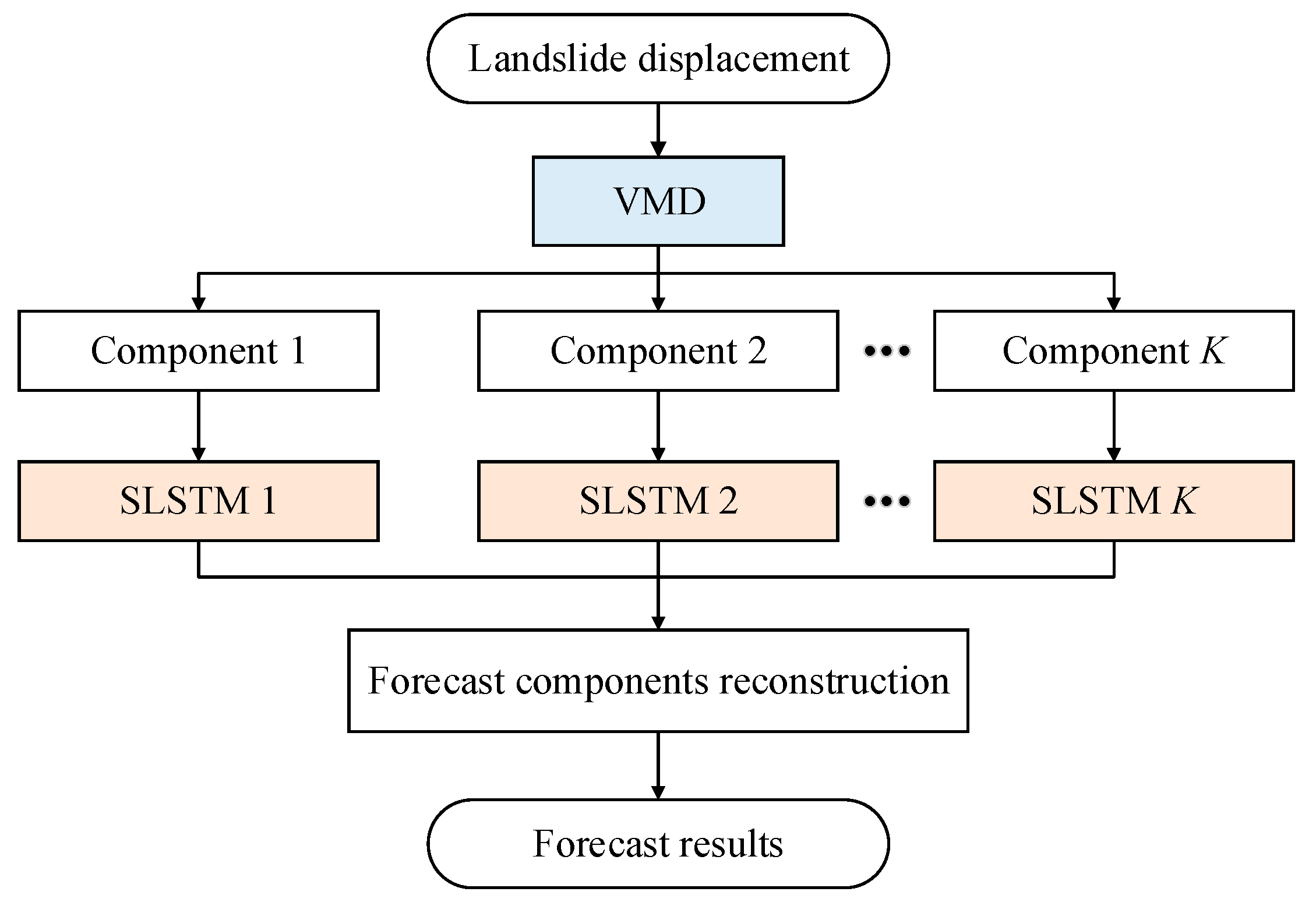
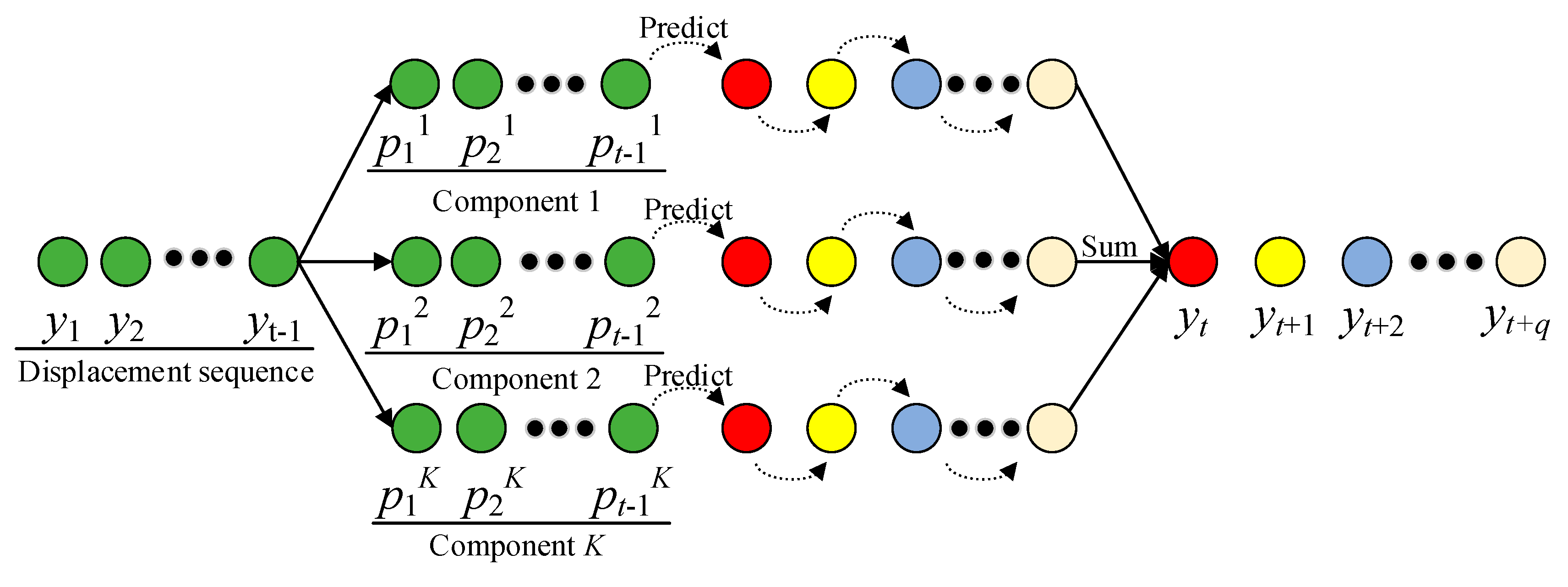
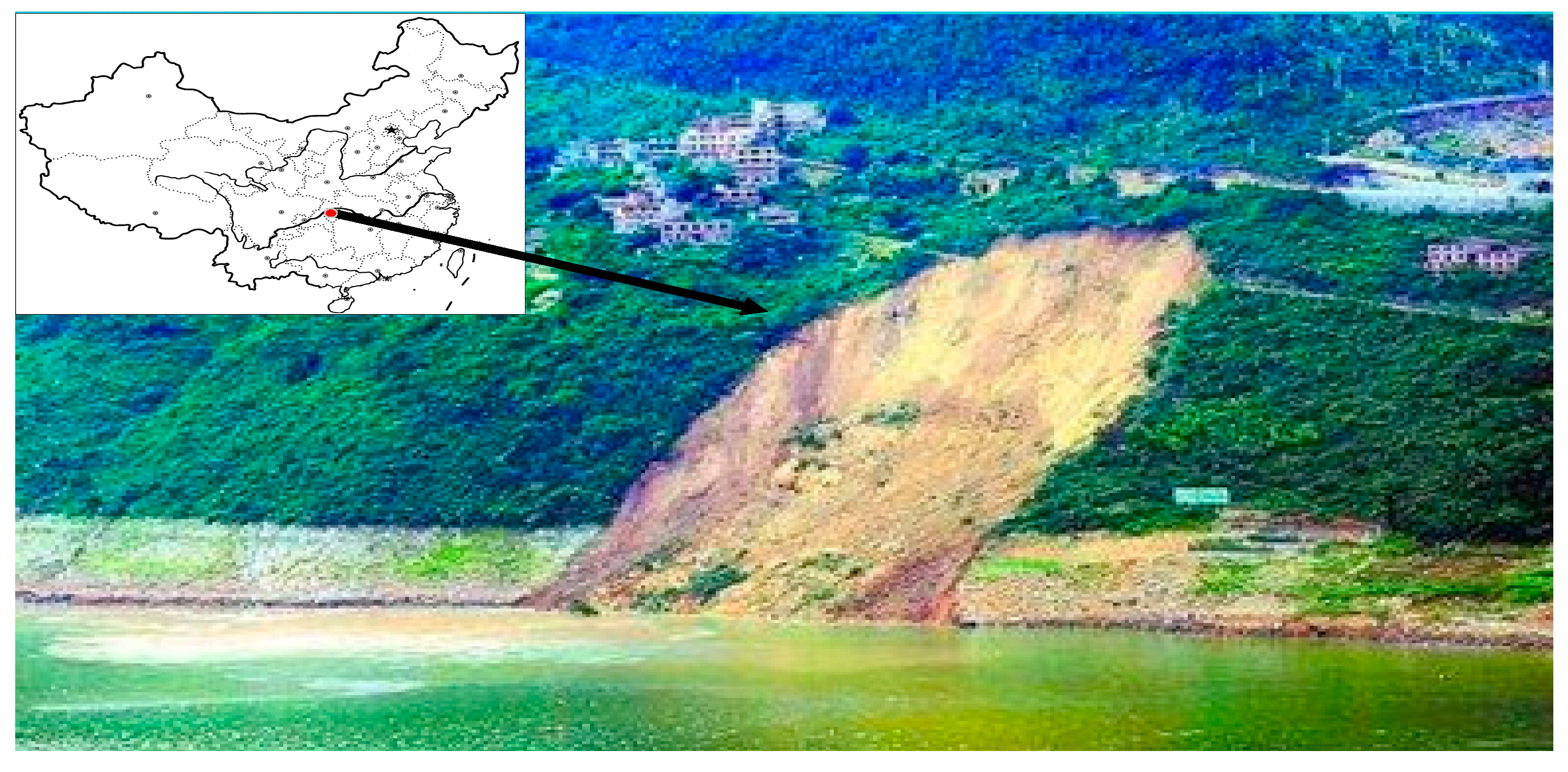
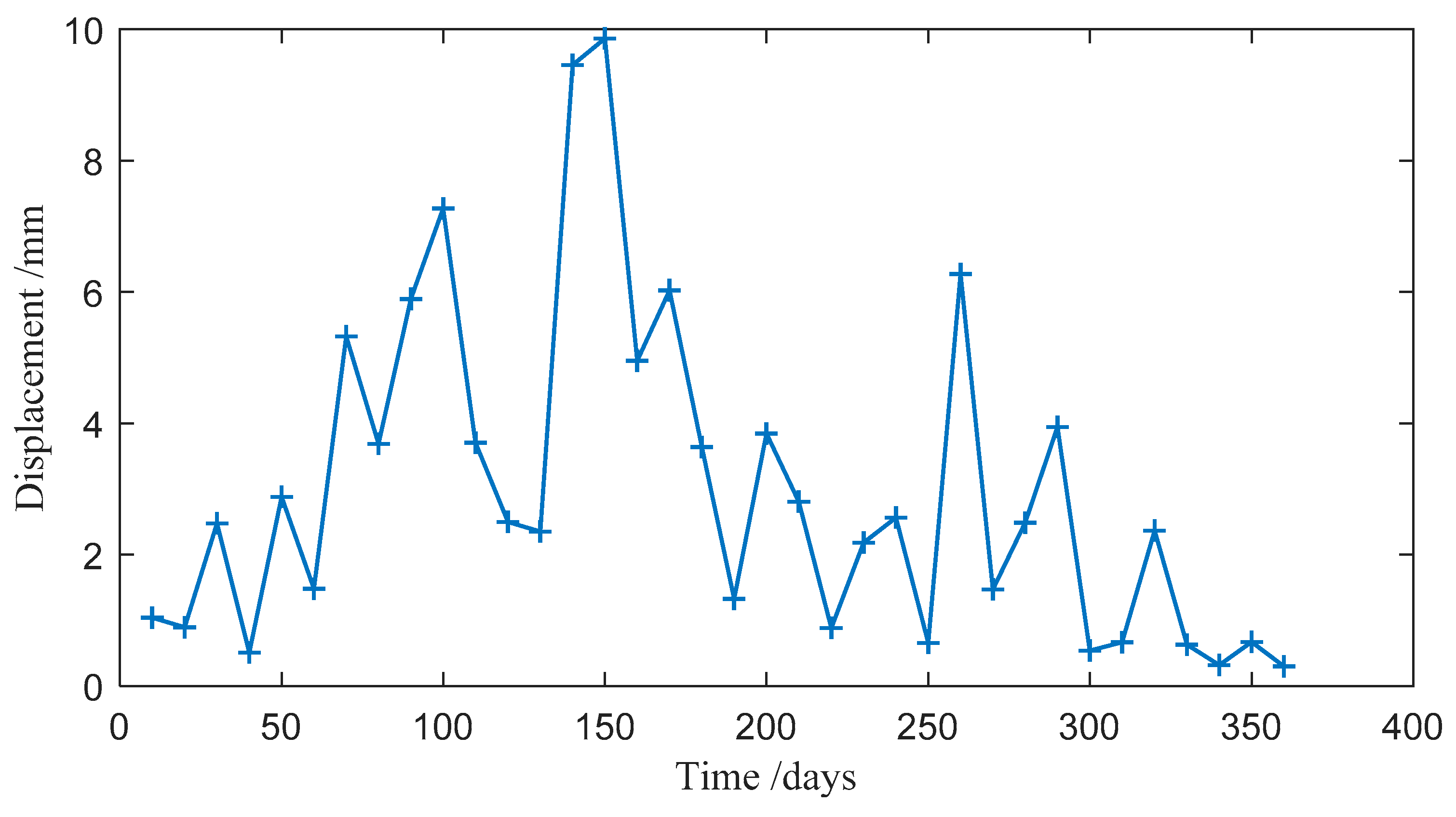
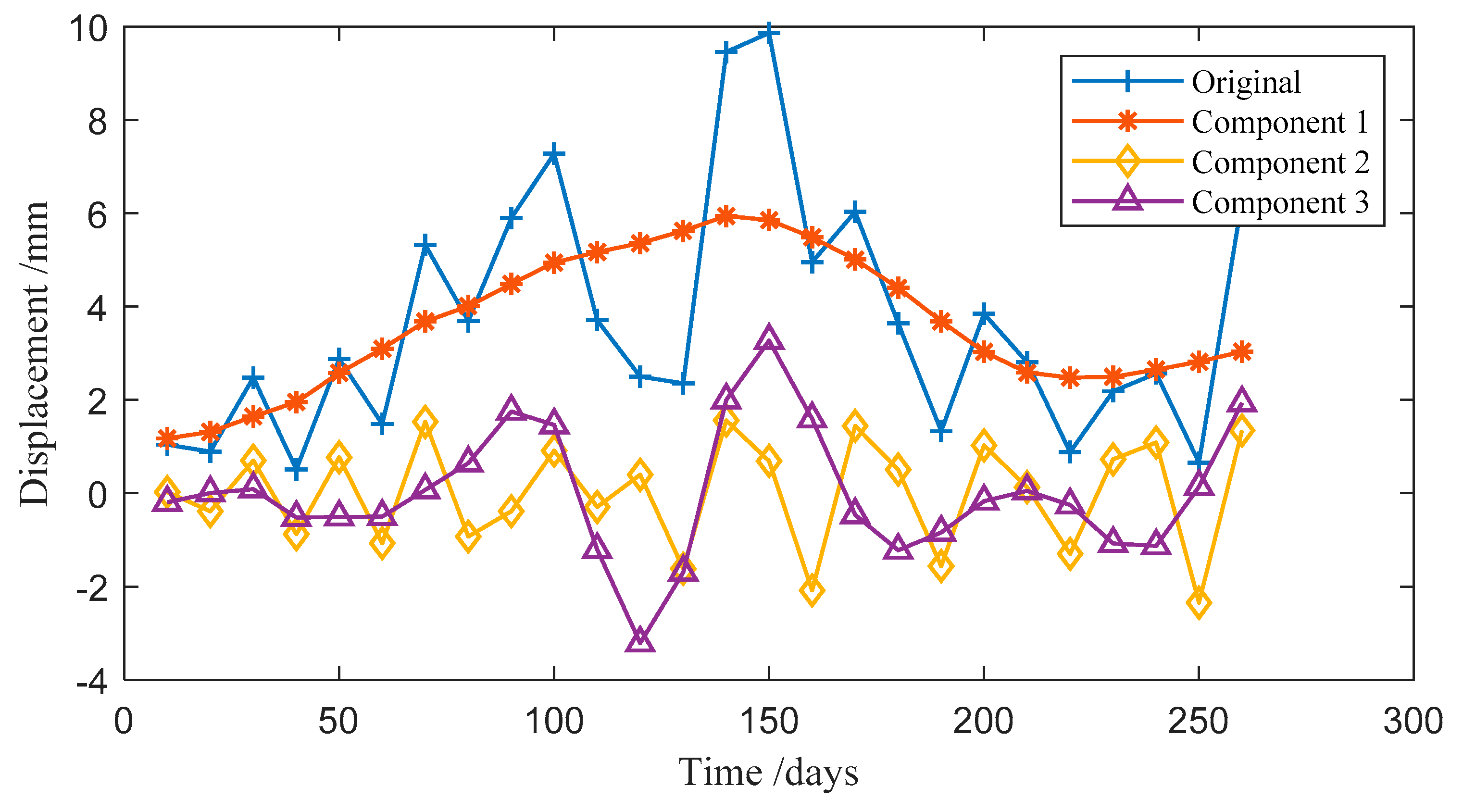
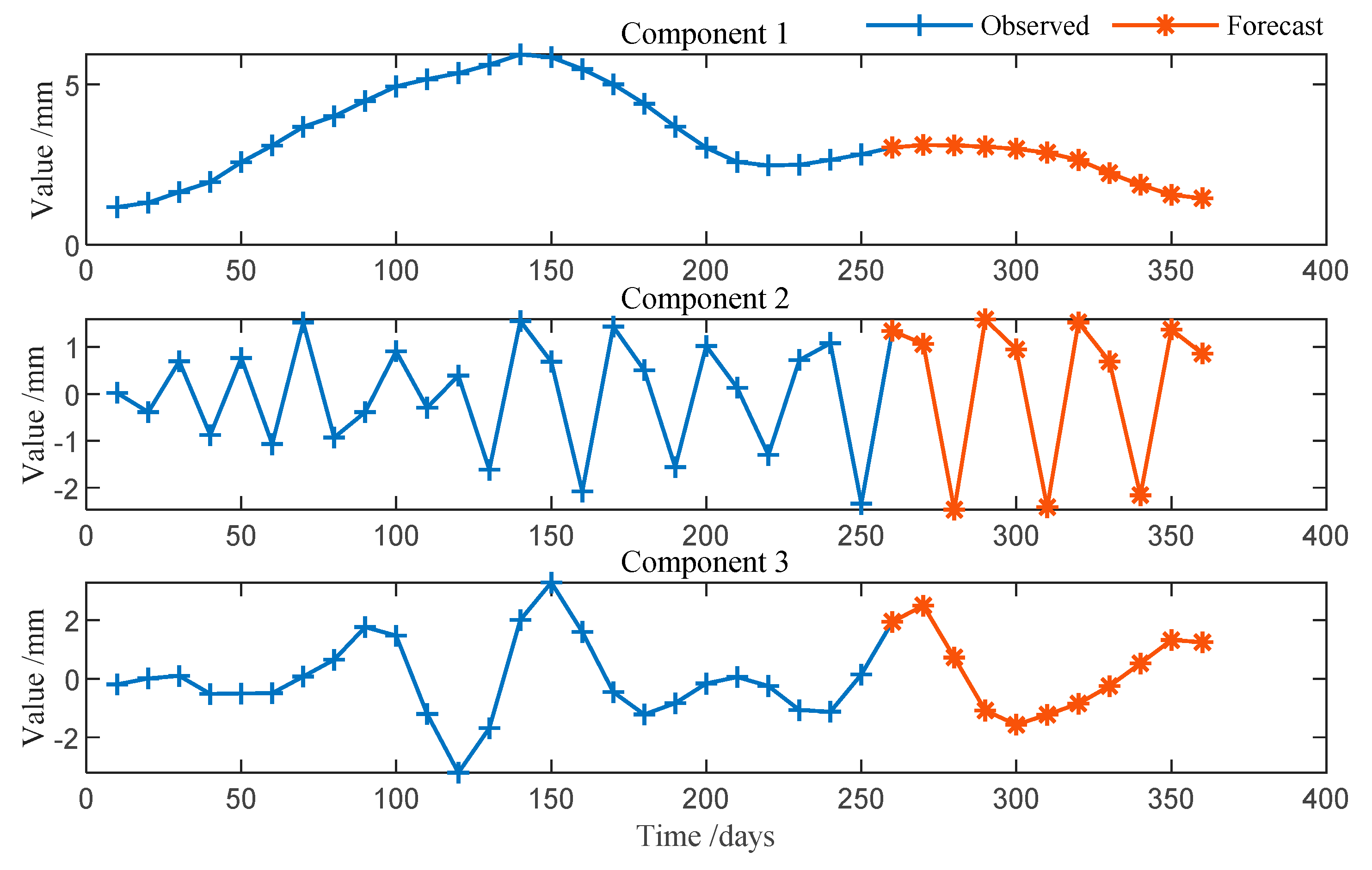
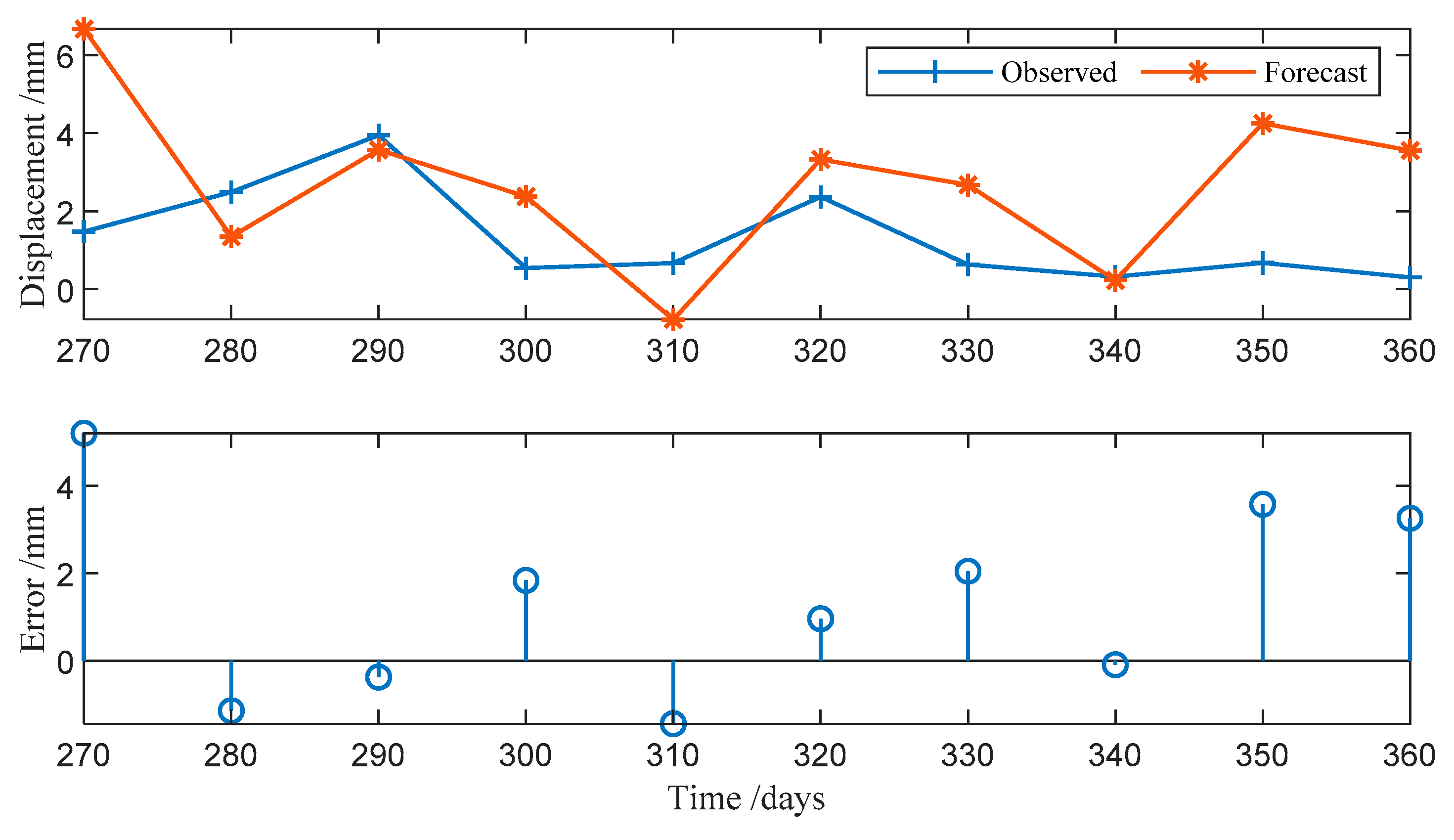
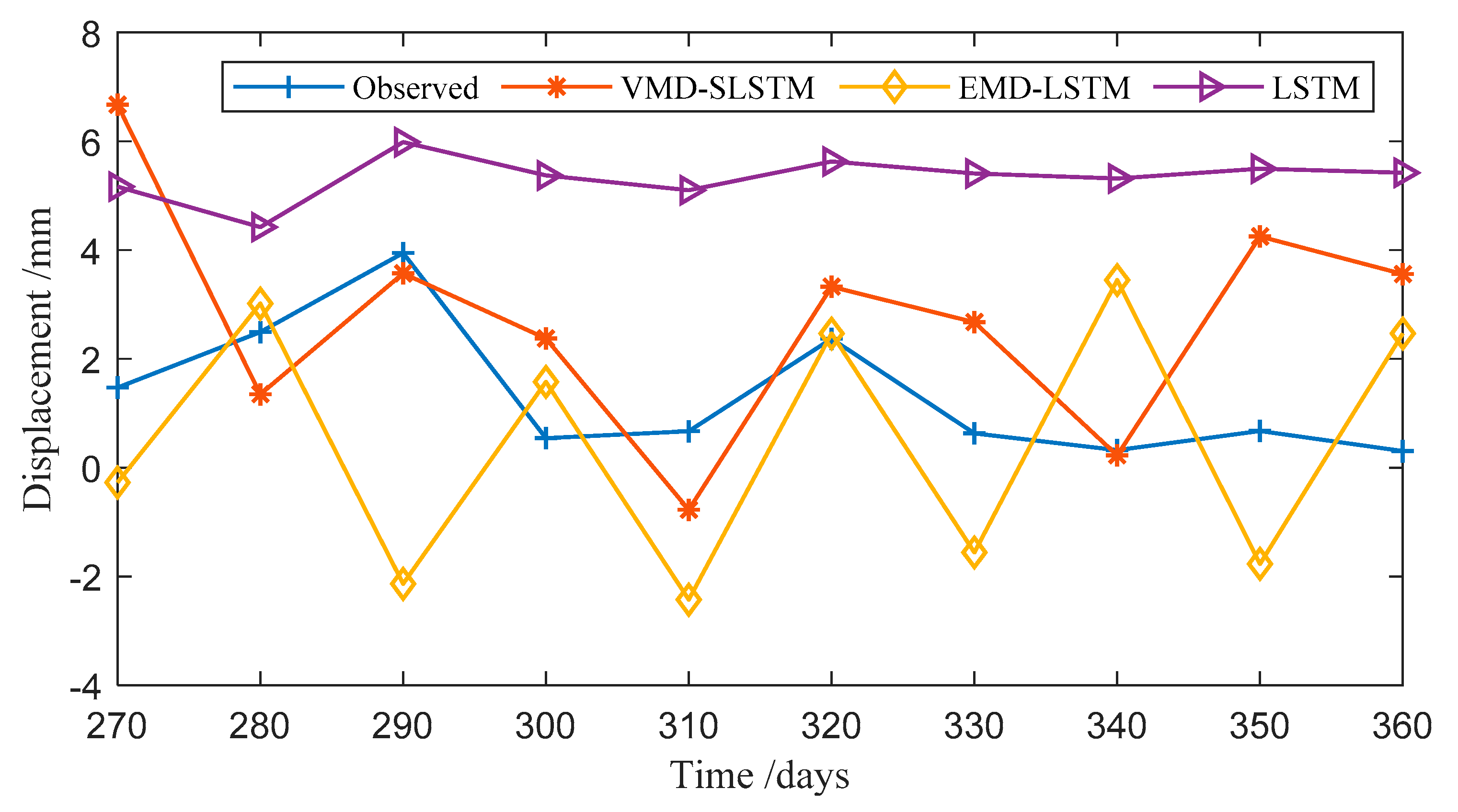
| Model | MAE/mm | RMSE/mm |
|---|---|---|
| LSTM network | 3.99 | 4.15 |
| EMD-LSTM network | 2.25 | 2.76 |
| VMD-SLSTM network | 1.99 | 2.50 |
© 2019 by the authors. Licensee MDPI, Basel, Switzerland. This article is an open access article distributed under the terms and conditions of the Creative Commons Attribution (CC BY) license (http://creativecommons.org/licenses/by/4.0/).
Share and Cite
Xing, Y.; Yue, J.; Chen, C.; Cong, K.; Zhu, S.; Bian, Y. Dynamic Displacement Forecasting of Dashuitian Landslide in China Using Variational Mode Decomposition and Stack Long Short-Term Memory Network. Appl. Sci. 2019, 9, 2951. https://doi.org/10.3390/app9152951
Xing Y, Yue J, Chen C, Cong K, Zhu S, Bian Y. Dynamic Displacement Forecasting of Dashuitian Landslide in China Using Variational Mode Decomposition and Stack Long Short-Term Memory Network. Applied Sciences. 2019; 9(15):2951. https://doi.org/10.3390/app9152951
Chicago/Turabian StyleXing, Yin, Jianping Yue, Chuang Chen, Kanglin Cong, Shaolin Zhu, and Yankai Bian. 2019. "Dynamic Displacement Forecasting of Dashuitian Landslide in China Using Variational Mode Decomposition and Stack Long Short-Term Memory Network" Applied Sciences 9, no. 15: 2951. https://doi.org/10.3390/app9152951
APA StyleXing, Y., Yue, J., Chen, C., Cong, K., Zhu, S., & Bian, Y. (2019). Dynamic Displacement Forecasting of Dashuitian Landslide in China Using Variational Mode Decomposition and Stack Long Short-Term Memory Network. Applied Sciences, 9(15), 2951. https://doi.org/10.3390/app9152951





